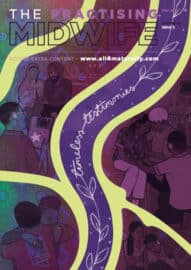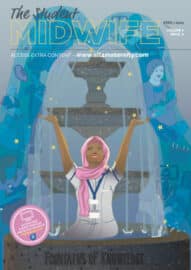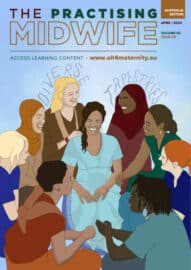Embracing the Power of ‘And’
Alys Einion – Associate Professor, Swansea University
Twitter: @AlysEinion
Re-published from Midwifery Matters Issue 168 March 2021 p36
Introduction
Nothing polarises a critical debate like controversy, particularly when two sides feel that their viewpoint is the only right way forward. Midwifery, arguably the oldest profession in the world, offers its practitioners a way of serving humanity through being present, and providing unconditional positive regard, physical, social and emotional support, and holding a space for families as they are born together. But we are dogged in modern times by a heritage of dogmatic and outmoded views which serve neither us or the women and birthing people we serve. In this article, I would like to address the ongoing challenge of providing inclusive midwifery care and birthwork through using additive language.
Language is powerful and highly symbolic.1 It elicits meaning, thought and feeling and represents not only our own expression of ourselves and our thoughts and ideas but also the dominant and prevailing cultural attitudes within our context – a context comprised of time, space and ideology. In recent weeks and months, midwives, birthworkers and motherhood activists have made strong arguments against the move to transform our culture of midwifery and birthwork by changing some of the language we use when describing, discussing and defining our clients, and when talking to them.
I pose a dangerously mundane resolution to the increasing hysteria that emerges when two poles collide: I suggest that we embrace the power of ‘and’.
As a lifelong feminist and a very impassioned midwife, I came into midwifery following an epiphany. I saw my life’s calling as being one of those skilled, loving beings who act as guardians of the givers of life, the pregnant woman and her awesome power to birth. I knew then as surely as I know now that women are oppressed, marginalised and disempowered, and that during pregnancy and birth, as in many other areas of life, their bodily and personal autonomy, agency and identity are undermined. Sexist language has perpetuated this inequality for women.2
I made it my life’s work to advocate for women who chose or accepted pregnancy and motherhood as part of their life journey. I grew to feminism on the tail end of the second wave, and was also fully invested in the radical feminist arguments against biological determinism – against the outmoded argument that has been used by patriarchal systems for so long, that women are biologically different (and inferior) to men and that the biology of the sexes defines what individuals are capable of, physically, cognitively and emotionally.3
I fought against gender stereotyping and this idea of exaggerated femininity and what we now know as toxic masculinity. I knew that this would be a life-long struggle. In midwifery, I also came to realise that, not only were birthing women’s very identities undermined by the limitations of a reductionist, biomedical system of ‘health’ care which treats the body as a machine and the birthing body as nothing more than a means of production, but that the systems within which people come to be were heterosexist, racist, classist and subject to a wide range of negative ideologies that limited the ability of individuals to experience empowered and fully-informed birth.
With the evolution of time and my own knowledge and understanding, and my work as an activist for LGBT+ equality, primarily within Higher Education, my fundamental vision also expanded, to include the need to actively promote the rights, wellbeing, autonomy and identities of trans and non-binary persons (TNB), and this includes TNB persons who bear, birth and parent children.
Ours is a profession of person-centredness, and our core and fundamental principles are, and always have been, to put the needs of our clients at the centre of our care.
Midwives are a source of infinite love
In few other professions do you enter into a professional relationship with a person and offer them love, nurture, support and excellent clinical safety within a few minutes. Ours is a profession of person-centredness, and our core and fundamental principles are, and always have been, to put the needs of our clients at the centre of our care. How then can we have become so polarised on the issue of expanding our loving and giving to be explicitly inclusive of diverse peoples? How can we find it so difficult to practice in an inclusive manner?
People with entrenched views pull against each other on both sides of this debate. On the one side, you have the very understandable sense of threat felt by women and for women that their identities and needs, their history of oppression and the challenges of living, birthing and parenting in a heteropatriachal and overtly sexist culture might cease to be recognised if the rights and needs of trans people are put front and centre.
On the other side, you have the equally understandable argument that birthing people who identify as trans or non-binary are extremely marginalised, poorly supported, and that the systems which oppress women, oppress gender diverse people to a much greater extent and with some very real and measurable impacts on health and wellbeing.
What I fail to see is why we are fighting against each other on this matter. Advocates for and against both positions have become polarised on the use of language. Should we use the term ‘woman’? This is after all, what midwife means when it is used in the English language. With woman. Midwives support women, don’t they? Should we use the term ‘person’? Pregnant person? Birthing person? Should we use the terms mother, father, or simply parent?
My answer to these questions is yes and yes; it is time to embrace the power of ‘and’.
By taking an additive approach, using gender-neutral language alongside the language of womanhood, we ensure that everyone is represented and included.
Additive language
And. It’s simple really. We will perhaps never reach a full consensus on the issue of language; language is in itself diverse, wonderful and full of a range of options. In English, we have a very easy resolution to this debate. By taking an additive approach, using gender-neutral language alongside the language of womanhood, we ensure that everyone is represented and included.
Women and birthing people. Women and pregnant people. Mothers, fathers and parents. Why do we need to exclude anyone? What purpose does it serve? Are we really so challenged by time and convention that we cannot continue to grow our knowledge and sensibilities, and make our core principles of unconditional positive regard manifest in the terms that we use? Why not simply use these terms, interchangeably, when we write, when we talk, when we describe pregnancy, birth, parenting, our clients, or colleagues?
Inclusivity doesn’t mean erasure. Women and mothers are not being replaced with gender neutral language. ‘And’ simply means everyone is included.
Just one tiny word with the power to change the world.
References
- Hunter LP. Women Give Birth and Pizzas Are Delivered: Language and Western Childbirth Paradigms. Journal of Midwifery and Health: 2006:51 (2) 119-124. org/10.1016/j.jmwh.2005.11.009
- Sczesny S, Moser F Wood W. Beyond Sexist Beliefs: How Do People Decide to Use Gender-Inclusive Language? Personality and Social Psychology Bulletin 2015:41(7), pp. 943–954. org/10.1177%2F0146167215585727
- Green S. Biological determinism and essentialism. In Naples NA (ed). Companion to Feminist Studies. John Wiley and Sons. 2020:pp13-34. org/10.1002/9781119314967.ch2









